Canning peaches at home allows you to preserve the flavors of summer. This recipe uses a very light syrup and less sugar, but check the recipe notes for alterations, whether you prefer to use honey or a sweeter syrup to preserve peaches.
This post and recipe was originally written in July 2018; it has been completely updated to reflect current safe canning methods.
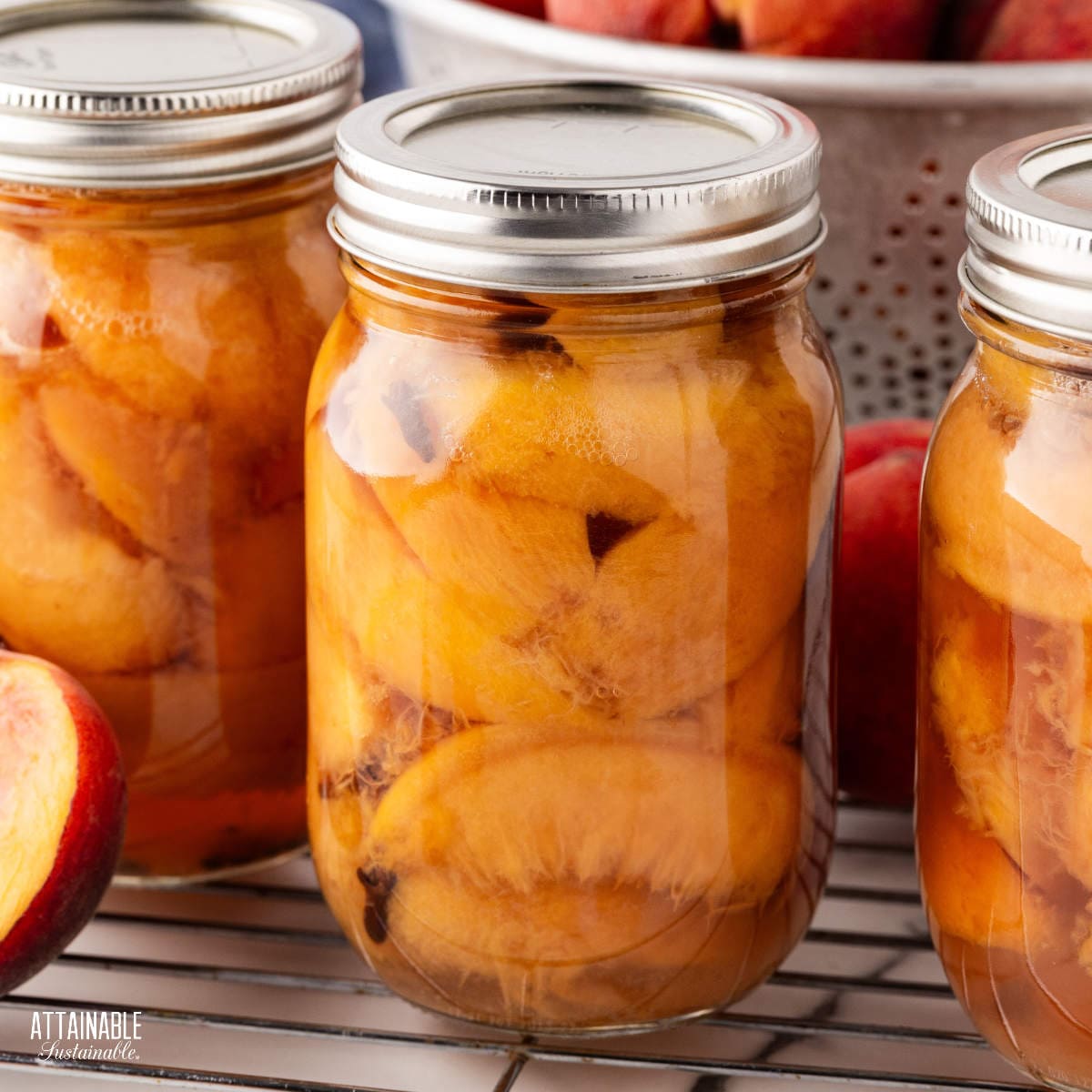
JUMP TO:
- Getting Started
- Ingredients
- How to Can Peaches with Less Sugar
- Make the Syrup
- Prepping the Peaches
- Prepare the Canning Pot
- Prepare the Jars
- Water Bath Canning
- Processing
Canning Peaches
Fresh peaches are one of the delights of summer and canning peaches is one way to preserve that flavor for use in the off-season. Preserving peaches for cobbler is one way to use them, but they’re great to top ice cream, or turn a jar or two into peach butter to enjoy when the season has passed.
Preserving peaches for the pantry is an easy canning recipe, one good for beginners. Why? Because they can be processed in a water bath. Peaches do not need to be pressure canned.
The process for home canned peaches isn’t difficult, but you will need to have some special canning equipment and a basic understanding of the water bath canning process. I cover the equipment in depth here, but here’s a quick overview of what you’ll need:
- Canner or large stock pot with a rack
- Jar lifter
- Canning jars (quarts or pints, wide mouth)
- Lids and rings
- Canning funnel
- Non-metal knife for removing bubbles
- Clean cloth for wiping jar rims
- Kitchen towel to line counter for processed jars
5 Easy Steps to Transform Your Pantry!
Ready to switch from store bought to homemade? Let me help you make some changes! Grab my FREE five-part guide to getting started.
Ingredients
Fresh peaches — Choose firm, ripe peaches for the best flavor. Use only yellow peaches for this recipe – white peaches are not acidic enough and there is no safe, tested method for canning white peaches.
Here’s where you’ll want to visit a farm or farmers market if you don’t have your own tree. Grocery store peaches just won’t have as much flavor. You’ll need about four pounds – 6-8 medium sized peaches – for this recipe.
There are two main types of peaches: cling and freestone. The names refer to how easy it is to remove the pit from the fruit. The pits of a cling peach will “cling” to the fruit and are more difficult to remove.
The pits of freestone peaches will often fall straight out of the fruit when cut in half, or they can be removed with just a gentle twist. This makes for a prettier slice when canning peaches.
Sweetener — Granulated sugar (I prefer organic) helps preserve the color and texture of the fruit. If you’d prefer, you can use honey.
Spices — Adding spices like a cinnamon stick, cloves, cardamom, or even a mixed chai blend makes these delicious spiced peaches. Opt for whole spices rather than powdered spices, which can cause cloudiness.
🍅 Safety First!
Canning is an excellent way to preserve food for the pantry, but there are some important safety considerations to keep in mind. The recipes on this site have been made following safe canning procedures by a certified Master Food Preserver.
- Know the difference between water bath canning and pressure canning. Low acid items must be pressure canned for safety.
- Altering ingredients may change the recipe’s pH, posing a safety issue.
- Use the proper jars and lids. Never reuse lids, with the exception of the Tattler or Harvest Right hard plastic lids that are intended for such a purpose.
- For more on canning equipment, please go here.
- Want to learn more? The National Center for Home Food Preservation is the go-to resource for safe canning information.
How to Can Peaches with Less Sugar
Canning peaches at home allows you to adjust the sweetness of the end product. And you can change the flavor up and make spiced peaches by adding flavors like cinnamon, clove, or a loose chai blend.
This recipe shows a raw pack method, which is just what you’d imagine: The peaches are packed into the canning jars in their raw state. See the recipe card below for how to use a hot pack pack method.
Make the Syrup
The liquid used in this recipe is a simple combination of sugar and water, heated to dissolve the sugar and make a sugar syrup. The syrup can be very light or very heavy or somewhere in between. Click here to download a copy of the sugar syrup cheat sheet above, so you’ll know what measurements to use for a variety of sweetnesses.
Canning peaches in light syrup: I tend to try to use as little sweetener as possible, so I almost always use a very light syrup. This allows the flavor of the peaches to shine through.
Canning peaches in heavy syrup: A heavier syrup is often used when you’re dealing with less ripe fruit that can benefit from a flavor boost.
Canning peaches with no sugar: Using a sugar syrup in canning can help the fruit retain its shape, color, and flavor, but if you’re really restricting sugar, canning peaches in water is perfectly safe.
Canning peaches in honey: You can substitute honey for the sugar in this recipe. Honey tends to be sweeter than sugar, so use 2/3 cup of honey for every cup of sugar.
Combine the sugar and water in a saucepan and heat until the sugar is dissolved; stir occasionally. Keep the syrup hot until you’re ready to use it.
Prepping the Peaches
Start by peeling the peaches using the blanching method to remove the skin from the peach flesh. To do so, cut an X in the bottom of the fruit, drop into boiling water for about 60 seconds, and transfer to ice cold water in a large bowl for another minute or so. This will loosen the skins so you can just slip them right off.
You’ll then need to decide if you want to can peach halves or slices. I tend to cut mine into slices, as it allows me to fit more into a jar. Go here to read more about cutting peaches.
If you’re concerned about the peaches retaining their color, you can hold the cut peaches in a mixture of one gallon of water and 3000mg of vitamin C (ascorbic acid).
Prepare the Canning Pot
Fill a large canner with water. Just how much water to use depends on the size of jar you’ll be processing. You’ll want the water level to sit at least an inch above the full jars during processing.
Do this before you begin filling the jars, since it can take awhile for the water to boil. Turn the heat to high and set the lid on the pot; this helps heat the water faster.
Prepare the Jars
Wash the canning jars and check the rims for nicks that could interfere with sealing. Wide mouth jars are recommended here, simply because it’s easier to pack the peaches.
For spiced peaches, add the optional dry spices to the jars.
Raw Pack for Canning Peaches
With the peaches peeled and sliced, pack the peach slices firmly into the jar, filling gaps as much as you can without smashing the fruit. This is your chance to utilize your puzzling skills.
Leave a 1/2″ headspace.
Once packed, pour the hot canning liquid over the fruit to a 1/2″ headspace. Slide a non-metal tool down inside the jar edge to release any bubbles. Double check the level of liquid and top each jar off, maintaining a 1/2″ headspace.
Use a damp cloth to wipe the rim of each jar; a little bit of food on the jar rim can prevent the lids from sealing properly.
Set the lids in place and screw the bands on firmly tight. Use a jar lifter to transfer jars into the gently boiling water. The water in the pot should cover the jars by at least an inch or two. If necessary add more water to the canner.
Processing
Cover the pot with a lid, return the water in the canner to a full boil, and process jars for the recommended time in a water bath canner. (See below.)
When time is up, use the jar lifter to transfer the jars to a flat surface that’s padded with a kitchen towel. Allow jars to cool completely. As they cool, you’ll begin to hear a canner’s favorite sound: That lovely little tink! that indicates a successful seal. Note that you don’t have to hear that sound for the jars to have sealed properly. Sometimes you do, sometimes you don’t.
Once jars are thoroughly cooled, check the seal on all of the jars. The lid should be concave and feel solid. If it flexes at all, it’s not sealed. (Place any jars that didn’t seal in the refrigerator and use them first. They are not shelf stable.)
Remove bands from cooled jars and rinse the jars. Store jars without the bands.
The Handcrafted Pantry

Ready to DIY your pantry with more wholesome ingredients? Check out my ebook, The Handcrafted Pantry! Filled with delicious recipes for some of your favorite condiments, snacks, and toppings, it’s the guide you need to start skipping packaged products and embrace homemade.
Note that if you live at an altitude above 1,000′ elevation, you may need to adjust the processing times. See processing times in the recipe card below. Check with your local cooperative extension office or visit the National Center for Home Food Preservation for more information.
Why are My Peaches Floating?
This is an issue more common with raw packed fruits than those that are hot packed. The air inside the uncooked fruit takes up space in the jar; when the fruit is processed and cooked, it shrinks, creating more space in the jar.
There are a couple of things that can contribute to floating fruit:
- Loosely packed fruit allows more room for fruit to float. To eliminate this problem, get those pieces of peach packed in the jar as snugly as you can without smashing them.
- Air bubbles. You’ll want to make sure you release any trapped air in the jars using a non-metallic knife or chopsticks.
Floating peaches may become dark and slightly discolored, especially if exposed to air, but the fruit is perfectly safe to eat.
★ Did you love this recipe? Be sure to give it a star rating below! ★
Have an abundance of peaches? Be sure to try this delicious fresh peach salsa recipe or make a batch of peach preserves!

Canned Peaches in a Very Light Syrup
Ingredients
- 6 - 8 fresh ripe peaches
- 4 cups water
- ½ cup sugar
- Optional spices: cinnamon sticks, cardamom, cloves, chai tea blend
Instructions
PREPARE FOR CANNING
- Wash the jars you'll use, making sure each is clean and free of nicks in the rim, which could impede sealing.
- Wash the lids and rings in hot soapy water. (If you're using non-Ball brand lids, prepare as suggested by manufacturer.)
- Place empty jars in a canning pot or large stock pot with enough water to cover by an inch or two, cover pot, and set on high heat. It can take awhile for the water to heat, so get it started before you begin making the recipe.
PREPPING THE PEACHES
- Fill a large pot with water and bring to a rolling boil. Use a knife to cut an X on the bottom of each peach.6 - 8 fresh ripe peaches
- Ease peaches into the boiling water and heat for 60 seconds.
- Use a slotted spoon to transfer the peaches into a bowl of ice water for 60 seconds, then remove to an empty bowl. Repeat with remaining peaches.
- Slip the skins from the peaches. Read more detailed instructions on blanching and peeling peaches here.
- Cut each peach in half, remove pit, and cut halves into 4 slices.
- To keep from darkening, place the slices in one gallon of water mixed with 3/4 cup lemon juice or 3,000mg of vitamin C (ascorbic acid).
- Boil 4 cups of water and sugar to make a very light syrup.4 cups water, 1/2 cup sugar
CANNING
- Remove jars from the canner, draining the water back into the pot.
- If using spices, add those to the empty jars.Optional spices: cinnamon sticks, cardamom, cloves, chai tea blend
- Pack peach slices into pint or quart jars, leaving ½" of headspace from the top of the jar.
- Cover the peaches with boiling syrup, maintaining the ½ inch headspace.
- Use a non-metallic tool around the inside of the jars to remove air bubbles. Add more syrup if necessary to maintain the ½" headspace.
- Wipe jar rims to remove any residue that may have spilled. A clean rim is essential to a good seal.
- Set jar lids in place. Screw bands on finger tight.
- Use a jar lifter to gently submerge jars into hot water in the canning pot. Water should cover the top of the jars by an inch or two. The water will cool somewhat in reaction to the addition of the jars. Return the water to a full boil and then set the timer.
- Process pints for 25 minutes, quarts for 30 minutes at 0-1,000' feet altitude; 30/35 minutes (pints/quarts) for elevations between 1,001-3,000'; 35/40 minutes (pints/quarts) for elevations between 3,001-6,000'; or 40/45 minutes (pints/quarts) over 6,000'.
- Remove jars from water using the jar lifter and transfer to a solid, towel-covered surface. Allow to cool for 24 hours.
- Check seals. Lids should be solid and pulled down tight. (if they flex and pop, the jar didn’t seal; put unsealed jars in the refrigerator and use those first).
- Remove rings and wash outsides of jars. Store in a cool, dry place.
Hot Packing Peaches for Canning
- Prepare syrup as directed. Place peach slices or halves to the syrup and bring to a boil.
- Use a slotted spoon to transfer peaches to jars; cover with hot syrup and proceed as directed above.
- For hot packed peaches, process pints for 20 minutes, quarts for 25 minutes at 0-1,000' feet altitude; 25/30 minutes (pints/quarts) for elevations between 1,001-3,000'; 30/35 minutes (pints/quarts) for elevations between 3,001-6,000'; or 35/40 minutes (pints/quarts) over 6,000'.
Notes
- These canned peaches have a shelf life of up to one year.
- To use honey, replace the sugar called for in this recipe with 1/3 cup honey.
- Boiling lids or heating above 180°F as once recommended can damage the sealing compound.
- Light syrup: 1 cup sugar in 4 cups water
- Medium syrup: 1-3/4 cups sugar in 4 cups water
- Heavy syrup: 2-3/4 cups sugar in 4 cups water
Nutrition
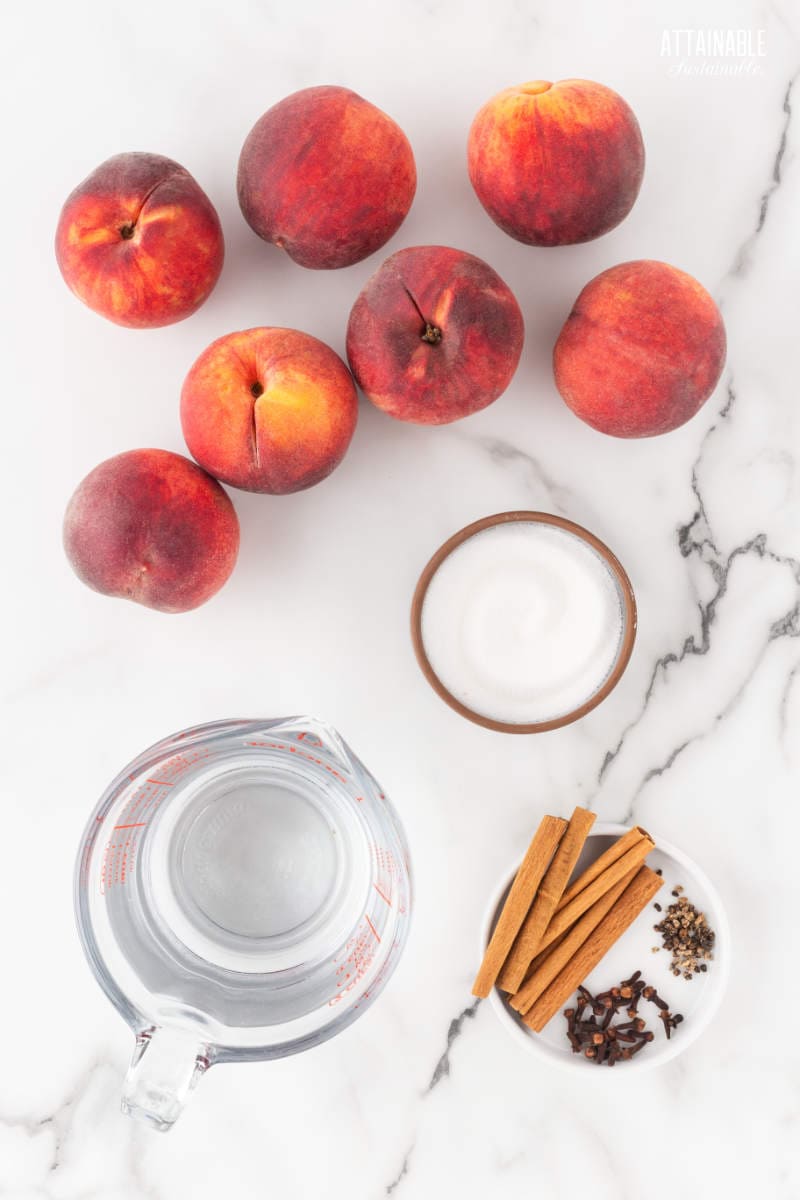
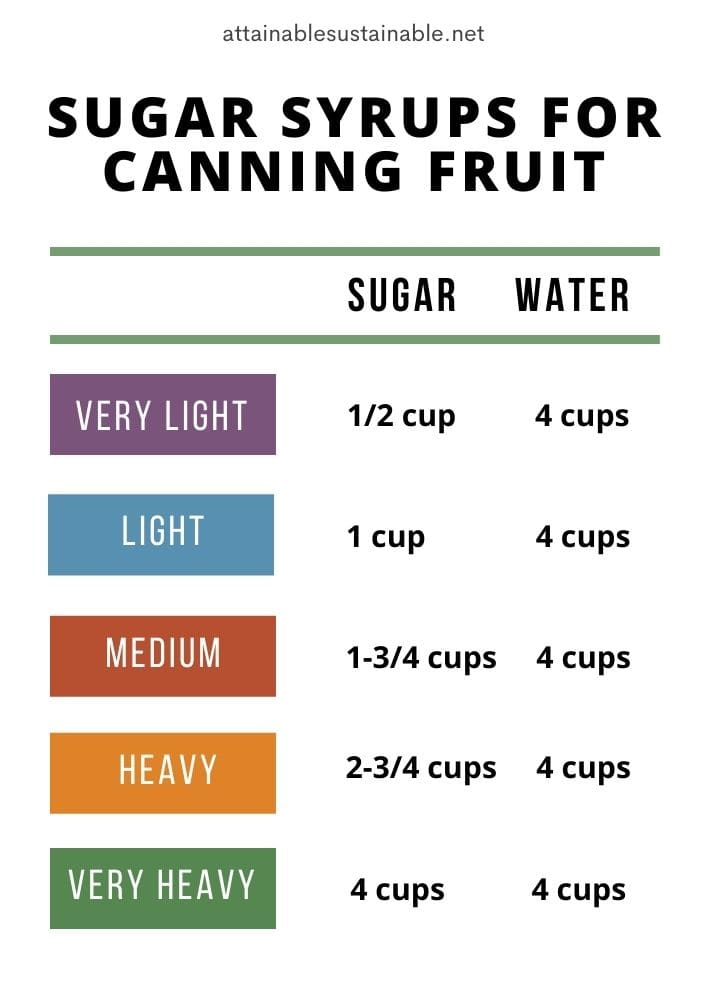
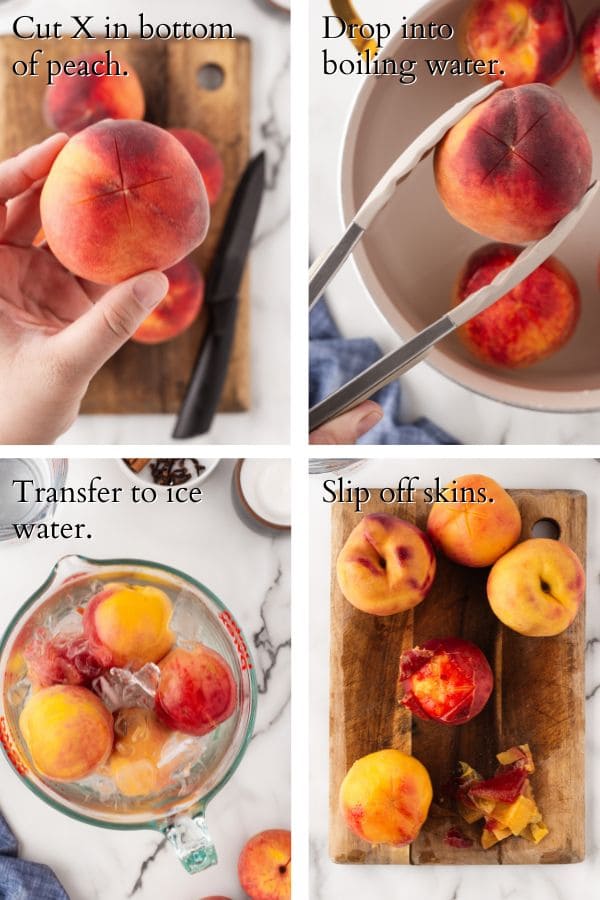

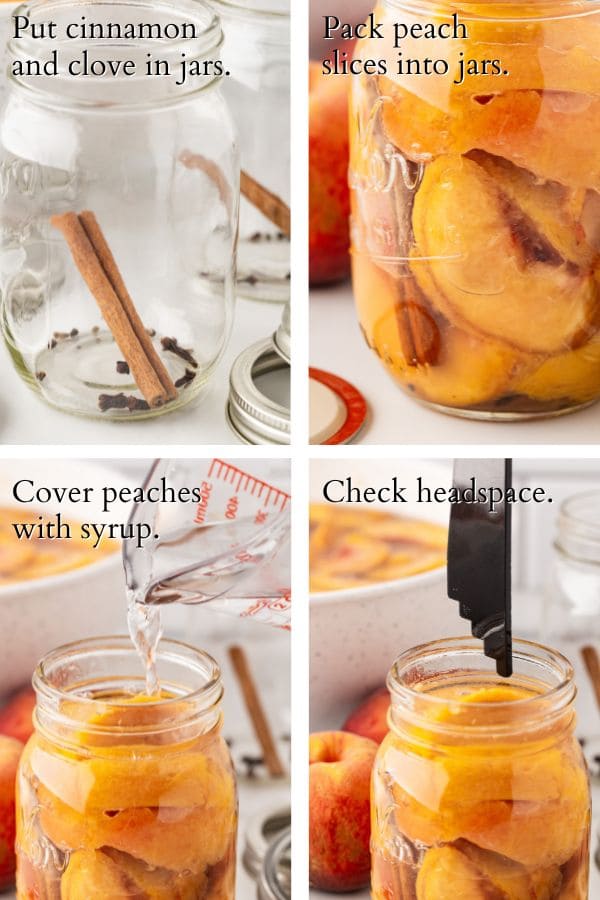
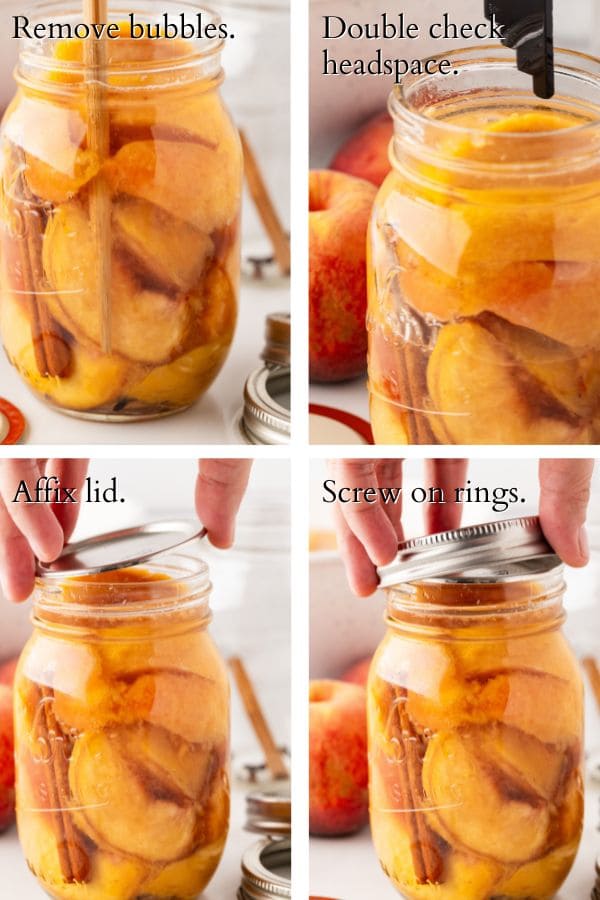
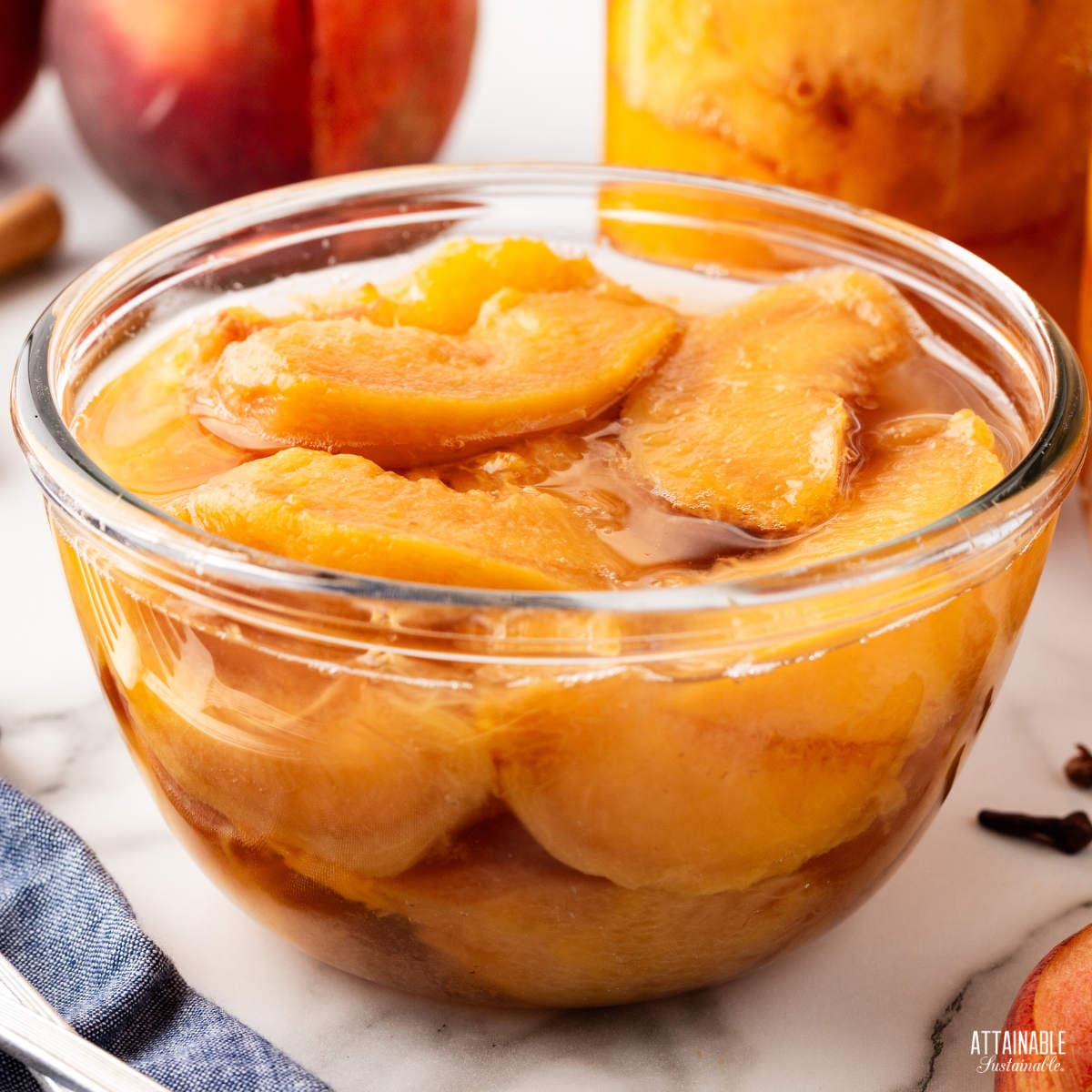
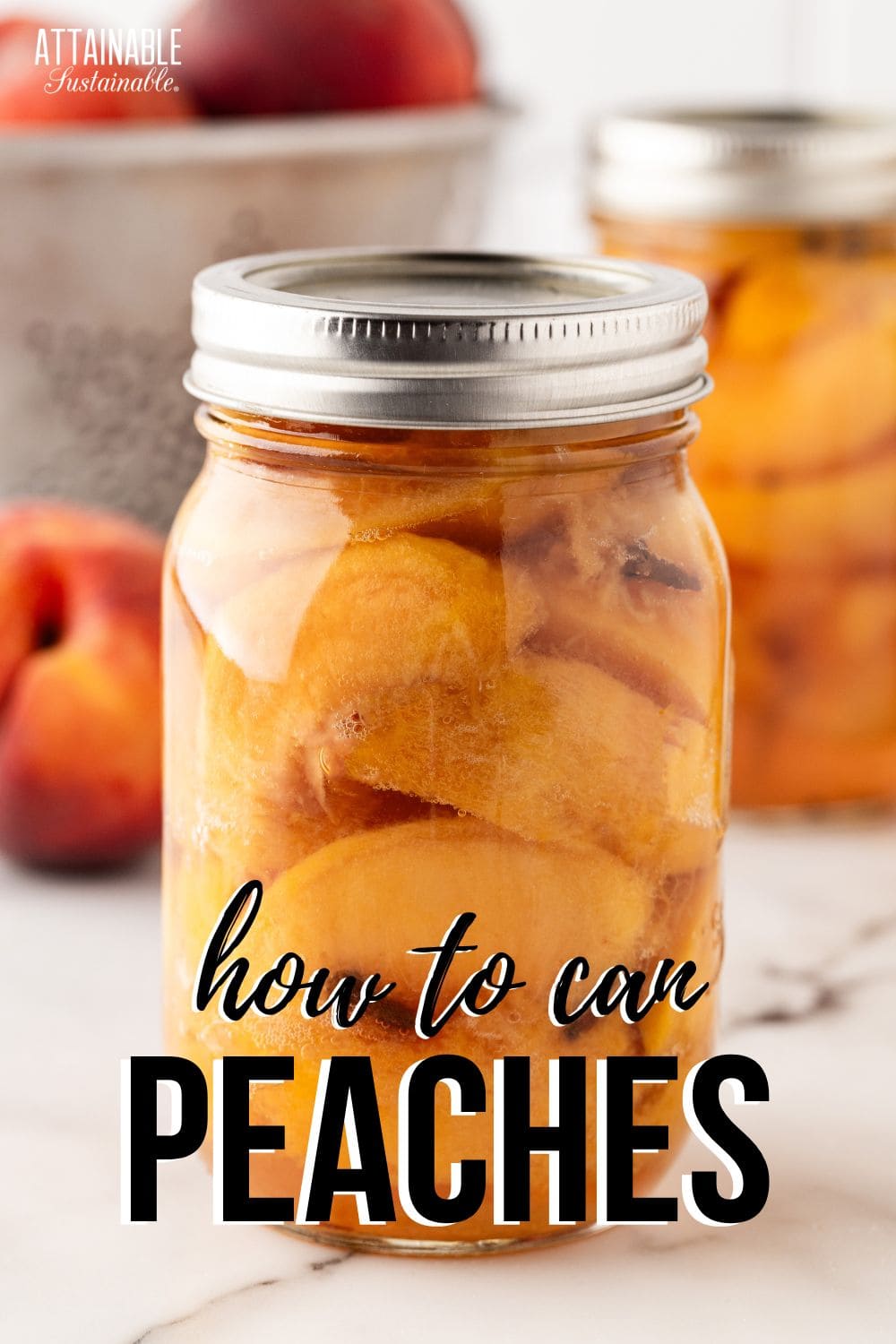





What size jars do you use and about how many jars will this recipe yield?
You can use pint or quart jars. How many will depend a bit on how tightly you pack the peaches, but you should get 3-4 pints(ish).
Are the pint jars heated or room temperature when you put the peaches in?
Heating them can help to prevent thermal shock when the jars go into the boiling water bath.
Chai tea sounds great. So do the other spices.
But how much would you use . ????
About a teaspoon per pint would be good!
You can also use salt to prevent the peaches from darkening. Salt is also a flavor enhancer. Remember to wipe the tops and threads of the jar before putting the lids and rings on the jar to ensure a good seal.